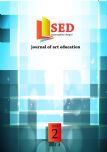ANARMONİK YAZIM VE ANARMONİK MODÜLASYON
ENHARMONIC SPELLING AND ENHARMONIC MODULATION
Author(s): Gökçe AltaySubject(s): Education, Music, Higher Education , Sociology of Art, Sociology of Education
Published by: Sanat ve Dil Araştırmaları Enstitüsü
Keywords: Music; Enharmonic Spelling; Enharmonic Modulation; Harmonic Analysis;
Summary/Abstract: The issue of harmony constitutes an important aspect of the courses of the institutions which are involved in the higher music education. The reason for this is that harmony is one of the most important elements of the polyphonic music formation. In this course, the student is expected to comprehend polyphonic music formations both theoretically and aurally. Related with that, the classical harmony courses may be formed into three main topics in accordance with its context. These topics may be systematized as diatonic, chromatic and enharmonic harmony. Each main topic must be approached in the right order and the harmonic context of the musical composition must be stated elaborately. In this study, the subject of enharmonic spelling and enharmonic modulation technique of the 18th and 19th century Western classical music is discussed. As an introductory statement, the basic principles of enharmonic spelling and enharmonic modulation are determined and theoretical examples are indicated. Related with the subject, a selected repertoire from the 18th and 19th centuries is analyzed in detail. In these harmonic analyses, both functional harmony and step degree methods are taken into consideration. In addition to that, the symbols and abbreviations which are used within the methods are also explained. As a result, it is stated that the transference of the issue to the student must be realized according to the principles of functional harmony within the musical context and some suggestions are made in this regard.
Journal: SED-Sanat Eğitimi Dergisi
- Issue Year: 3/2015
- Issue No: 2
- Page Range: 39-55
- Page Count: 17
- Language: Turkish

